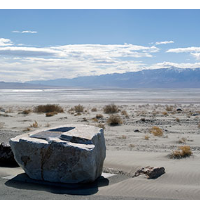Yet Another Truce Declared over Owens Dry Lake
 Owens Lake (photo: Daniel Acker, Bloomberg)
Owens Lake (photo: Daniel Acker, Bloomberg)
Who knew that decades of acrimony between the city of Los Angeles and Owens Valley might have been avoided by just plowing ditches in the Owens (Dry) Lake?
On Friday, the overseer of Owens Valley air quality and L.A. settled yet another lawsuit over the city’s legal commitment to contain the dust left behind after it sucked all the water out of the lake in the early part of the last century. The latest impasse was overcome when the Los Angeles Department of Water and Power (DWP) said it would employ a new technique of dust control to replace a chunk of its expensive, and drought-proscribed, current method of flooding over 50 square miles or so of desert terrain.
The DWP expects to cut sharply into the 25 billion gallons of water it annually dumps on the dry lake using bulldozers to essentially till the soil by digging deep rows that will flip a layer of clay on top of the dust. Eventually, it could cut the water usage nearly in half, they say.
Owens Valley residents have been displeased with Los Angeles, 200 miles to the south, since agents of the city, pretending to be otherwise, first bought up property in the area and used the water rights to feed the newly-constructed Los Angeles Aqueduct. The origin of the fight was glorified in the 1974 movie “Chinatown,” a fictional account of the water diversion that began in 1913, and ended little more than a decade later when the lake went dry. Farmers were devastated and the area has been wracked by dust storms and drought ever since.
After years of litigation, agreements in 1997 and 2008 required the DWP to cooperate with the Great Basin Unified Air Pollution Control District to do something about the air quality problems caused by the swirling dust. But the conflict hardly abated. Great Basin executive officer Ted Schade told the Los Angeles Daily News there had been 12 lawsuits and appeals filed in the last three years.
“It’s a big deal,” Schade said. “We’re going to stop fighting for the first time in years.”
Or not.
Los Angeles thought it had fulfilled responsibilities initially spelled out in the 1997 accord at a cost of $1.2 billion. The city argued that it had reduced air pollution by 90%, and that Great Basin was unreasonable in its new demands. But a federal judge disagreed in May 2013 and said the city was on the hook for at least another $400 million.
Schade, who has fought with the DWP for 24 years and was often at odds with valley residents who feared the DWP, is confident that this time a deal has been struck that will stick. After the settlement agreement, he announced he was retiring because, “My job here is done.”
Valley resident and activist Daniel Pritchett told the Daily News he isn’t so sure. “The DWP makes agreements with Great Basin every couple of years, and then there’s a change in management at the DWP or a new mayor. And then they turn around and sue Great Basin again.”
–Ken Broder
To Learn More:
Settlement Reached over Dust Control Measures at Owens Lake (by Dakota Smith, Los Angeles Daily News)
More Water Coming to LA as Long-Running Owens Valley Dispute Ends (by Molly Peterson, KPCC)
New Dust-Busting Method Ends L.A.'s Longtime Feud with Owens Valley (by Louis Sahagun, Los Angeles Times)
Judge Won’t Let Los Angeles End Its Owens Lake Restoration (by Ken Broder, AllGov California)
L.A. Sues to End the Century-Old Owens Lake Saga (by Ken Broder, AllGov California)
- Top Stories
- Controversies
- Where is the Money Going?
- California and the Nation
- Appointments and Resignations
- Unusual News
- Latest News
- California Forbids U.S. Immigration Agents from Pretending to be Police
- California Lawmakers Urged to Strip “Self-Dealing” Tax Board of Its Duties
- Big Oil’s Grip on California
- Santa Cruz Police See Homeland Security Betrayal in Use of Gang Roundup as Cover for Immigration Raid
- Oil Companies Face Deadline to Stop Polluting California Groundwater





